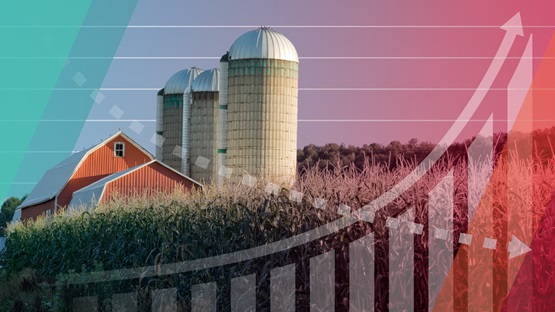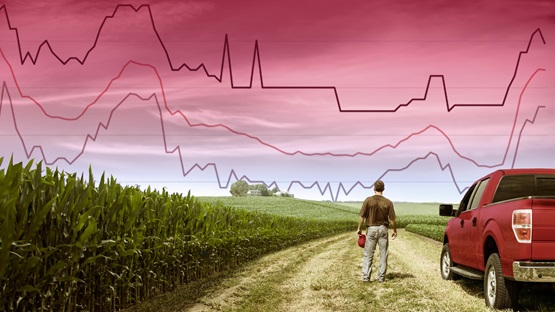Ninth District community banks know that the agricultural sector’s financial health drives changes in agricultural lending.1 The volatility of agricultural income and expenses requires ongoing assessment of credit needs, and community banks in the district play an important role in this process. About half of the district’s 457 community banks are considered agricultural banks.2 Agricultural banks hold over two-thirds of outstanding agricultural debt in the Ninth District, totaling over $14 billion at year-end 2021, which demonstrates how agricultural lending is a critical component of a rural economy.
2020 and 2021 farm sector income—better than expected
After five years of below-average farm income, the agriculture industry, producers, and bankers headed into 2020 with optimism. The optimism was short lived, however, as the COVID-19 pandemic caused uncertainty in global markets. The initial uncertainty triggered declines in agricultural commodity prices, which dropped by 11.4 percent in one month.3
Sinking commodity prices were met with pandemic aid packages for the agricultural sector, which quickly improved farm sector income and financial conditions in 2020. Bankers and industry leaders throughout the Ninth District reported that aid packages greatly improved the financial condition of agricultural producers affected by the commodity price drops.4 In fact, many noted that producers replenished working capital and paid down outstanding debts as the producers' financial situation rapidly changed.
Additionally, commodity prices rose in the latter half of 2020 as demand and exports exceeded expectations. Supply constraints also contributed to the increasing commodity prices. Strong prices continued into 2021, boosting farm sector income to the second highest on record (see Chart 1; highest was 2013).
Increased income and decreased agricultural loans
Rapidly improving financial conditions for agricultural producers led to increased loan repayment rates and reduced loan demand, which quickly reduced outstanding loan balances at agricultural banks in the district. Non-real estate loans outstanding at the end of the first quarter in 2021 were $1.6 billion (21.1 percent) lower than the same quarter in 2020 (Charts 2 and 3). Farmland loan debt outstanding also saw a decline, albeit smaller, dropping by $1.0 billion (12.2 percent) during the same period.
The fourth-quarter 2021 Call Report data show year-over-year changes in outstanding agricultural loan balances stabilizing at district banks. Both non-real estate and farmland loan balances increased slightly in the fourth quarter, with non-real estate loans outstanding still a bit lower than the previous year. The rapid decline of outstanding non-real estate loan balances reversed in the second quarter of 2021, as operating renewal season concluded and cash flow projections included increased production costs. Outstanding balances for real estate loans grew more rapidly than non-real estate loans as farmland values surged and increased farmland sales pushed loan balances higher.
Non-real estate loan demand growth expected in 2022
Given their familiarity with the local producers, agricultural bank lenders throughout the Ninth District have detailed knowledge of the credit needs in their market areas. Each quarter, these lenders provide us with insight on the agricultural market and credit conditions in their trade areas through the Minneapolis Fed’s Agricultural Credit Conditions Survey.
Our survey results show similar trends to the data discussed in the previous section, and forecast additional information on borrowers’ financial performance, credit needs, and trends in the district’s agricultural economy. After several years of below-average farm income and increasing farm debt levels, loan repayment rates increased quickly as farm income sharply rose in 2020 (Chart 4). Non-real estate loan demand decreased as farm income increased, but at a more gradual pace compared to changes in repayment rates. However, survey respondents expect this trend may shift into the early part of 2022 as input and production costs rapidly increase.
Agricultural producers and community banks have a unique relationship due to the cyclical nature of agricultural production. Farm income can vary significantly between operating cycles, creating funding gaps and additional credit needs for variable expenses. In some cases, weak loan demand can decrease quickly to concerning levels for banks’ profitability. In other cases, unexpected expenses can squeeze initial cash flow projections, increasing demand for additional credit and pushing loan balances higher. Based on the most recent agricultural credit survey results in the district, it looks like we may be approaching the latter.
Endnotes
1 Community banks are banks with total assets less than $10 billion.
2 Agricultural banks are banks where farm production loans and farm real estate loans comprise at least 25 percent of total loans during a quarter. Data from Call Report, as of December 31, 2021, for community banks headquartered in the Ninth District.
3 Author calculated the decrease between March 2020 and April 2020 using the U.S. Department of Agriculture, National Agricultural Statistical Service’s Agricultural Production Index values. The index is a broad measure of prices received by producers for crop and livestock commodities. For more information, visit the NASS Prices Survey page at https://www.nass.usda.gov/Surveys/Guide_to_NASS_Surveys/Prices/
4 The major federal programs for agricultural commodity producers were the Coronavirus Food Assistance Program (CFAP) and the Paycheck Protection Program (PPP). As of March 6, 2022, the CFAP disbursements to producers in the Ninth District states totaled $6.3 billion. The largest dollar amount of PPP loans outstanding was in the quarter ending June 30, 2021, when total amounts outstanding was $2.4 billion at community banks headquartered in the Ninth District.





